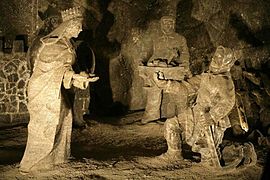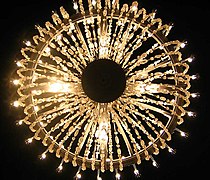Wieliczka Salt Mine

The Wieliczka Salt Mine in the southern Polish city of Wieliczka ( German Groß Salze ) is one of the oldest and most famous salt mines in the world. Together with the Salt Mine Bochnia and the salt Grafenschloss Wieliczka it forms the UNESCO - World Heritage Site Royal salt mines of Wieliczka and Bochnia .
geology
See → Geology of the UNESCO World Heritage Royal Salt Mines Wieliczka and Bochnia
history
The salt works in the Wieliczka area is very old. When the salt springs were exhausted in the middle of the 13th century, salt brine was searched underground and the rock salt deposit was discovered.
The Goryszowskischacht was about 1280 sunk . Machines have been used in the mine since the 15th century and horses since the 17th century . Up until the 18th century, mining was only carried out in the upper part of the seam , down to a depth of around 60 m ; later, four more levels were created under the old structures, which extend to a depth of 340 m.
From the 14th century to 1772, the Wieliczka and Bochnia salt mines were united as the Royal Saltworks, making them the largest mining company in Poland.
In 1368 Casimir the Great issued a mountain code that regulated salt production and trade . The administration of the salt pans was the responsibility of a salt count who had his seat in Wieliczka Castle . The income from the salt trade, which during its heyday from the 14th to the 16th century generated a third of the state's income, was used to cover the costs of building the Wawel , the academy and the city fortifications in Krakow, as well as the army pay .
20th century
The salt works , which is still in operation today, was built in 1913 . After 1918 the mine became state property of the Republic of Poland , which in 1932 reserved the state monopoly on salt. In 1965 the salt works from Żupa Solna (Salt Mine) were renamed Wieliczka . In 1976 the mine was included in the list of national cultural monuments of Poland and in 1978 in the UNESCO list of world cultural and natural heritage .
In 1992 a water ingress triggered a break in the valley at the train station and the monastery. The mine and the monastery were secured by a rescue operation. In 1993 salt production was stopped. Since then, the mine has been used exclusively for tourism and as a sanatorium . In order to prevent the mine and the city from collapsing in the event of water ingress, the penetrating water is brought to the surface and evaporated salt is extracted from it. As a result, Wieliczka continues to be an important Polish salt producer.
In 1994 the salt mine monument to the history of the Polish nation and in the year 1989 list of endangered world heritage added. In 2013, UNESCO expanded the world heritage to include the Salzgrafenschloss and the royal salt mine in Bochnia , where rock salt has been mined since the 13th century.
tourism
In addition to the extraction chambers, there is a tourist route down to a depth of 130 meters, a healing gallery for the treatment of respiratory diseases , and some of the halls can be rented for celebrations in the mine.
The moisture in the breath of the visitors has caused severe damage to the sculptures over many decades, including discoloration and deformation. New ventilation systems mean that sufficient dehumidification has been achieved in the main rooms in order to prevent further damage.
Horn of the Salt Miners
Others
Well-known are the copper engravings by Wilhelm Hondius from Danzig from 1645 on the city and the mine, as well as by Johann Gottfried Borlach from 1719 and by Johannes Esaias Nilson (1760–1790) on the mine operation.
Parts of the film Sex Mission were shot in the mine .
See also
literature
- Johann Nepomuk Hrdina: History of the Wieliczka Saltworks . Carl Gerold Publishing House, Vienna 1842 ( digitized version )
- Jonathan Lee: 50 great adventures. Special places and the people who created them . Munich: Prestel Verlag, 2006, ISBN 3-7913-3530-8
- Reiner Zeeb: Johann Esaias Nilsons [copper engraving] "Salzbergwerk Wielicka" (1760) and the new partial catalog. Critical Reports 30, Issue 3, 2002, pp. 79–85 ( PDF download from Heidelberg University, 4.4 MB)
Individual evidence
- ↑ Kurt Schlünkes: natural paradises and cultural treasures of mankind. The 19 new UNESCO World Heritage Sites. Retrieved July 22, 2013 .
Web links
- Official website of the "Wieliczka" Salt Mine
- Wieliczka The salt of the Earth /
- www.schaetze-der-welt.de (Wieliczka Salt Mine)
- www.wieliczka.pl (Wieliczka County Internet portal with the city and mine website)
- www.wieliczka.nu (Mining Museum in the Salzgrafenschloss Wieliczka)
- Europe's underworlds: The Wieliczka Salt Mine , Deutsche Welle (Video 4:06)
Coordinates: 49 ° 59 ′ 1 ″ N , 20 ° 3 ′ 20 ″ E




